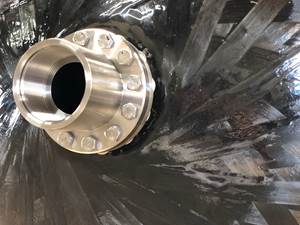Composites for every powertrain
CT columnist Dale Brosius, the head of his own consulting company and the president of Dayton, Ohio-based Quickstep Composites, the U.S. subsidiary of Australia-based Quickstep Technologies (Bankstown Airport, New South Wales), comments on the role composites have played as the automotive powertrain has evolved.
An advertisement currently running on U.S. television shows numerous people trying to stop a woman from putting diesel fuel into her luxury passenger car, simply because they believe she is mistakenly grabbing the wrong fueling hose. Turns out, the vehicle she owns is an Audi, with a modern diesel engine, a rarity in America. Our readers in Europe would likely scratch their collective heads about this, given that diesel engines make up a significant portion of the powertrains in European vehicles, and have for decades.
Seeing this advertisement brought back memories of the early 1980s, when Volkswagen (VW, Wolfsburg, Germany) produced hundreds of thousands of diesel-powered Rabbit vehicles — based on the European VW Golf — in VW’s Pennsylvania assembly plant. My general recollection of the Rabbit involves lots of black smoke emanating from the tailpipe. Within a few years, diesel-fueled small cars largely disappeared from the U.S. landscape and standard combustion engines regained overwhelming dominance.
Such was not the case in Europe, where OEMs invested heavily in cleaner, more efficient diesel engines. Today’s diesels offer quiet performance with high fuel economy and greater power. Composites have played a role in these advancements, including the application of glass-reinforced plastics in fuel rails, vacuum pumps and diesel fuel preheaters. A number of thermoplastic and thermoset composites are used under the hood in valve covers, water pumps and other components also common to gasoline engines.
So, are diesel engines poised for large growth in America, or will they achieve only niche status? Time will tell. It seems that we have been through a number of innovations on about 10-year intervals that promise energy independence, higher fuel economy and/or reduced emissions. In each of these developments, composites have provided enabling functionality.
Around 1990, there was a strong push to fuel vehicles with compressed natural gas (CNG), offering a lower cost per mile (or km) traveled. At that time, heavy steel pressure vessels were essentially 100 percent of the CNG storage tank market, but new standards were created that incorporated fiberglass or carbon fiber as structural overwraps. These provided additional strength to metal shells or plastic liners, yielding lighter tanks and increased gas capacity. However, the lack of a refueling infrastructure and limited driving range stifled mass adoption. Today, although upwards of 10 million natural gas tanks are produced annually, less than 20 percent have composite overwraps, and only a fraction of these use carbon fiber. CNG makes sense for taxi and delivery fleets, as well as urban buses that return each night to a central location for refueling, but it’s a rarity for families and commuters.
A decade later (circa. 2000), hydrogen fuel cells were all the rage. Japan’s Honda (Tokyo), Germany’s Mercedes-Benz (Stuttgart) and Detroit, Mich.-based General Motors (GM) in the U.S. all set up fuel-cell development centers and put test vehicles on the road. Canadian supplier Ballard Material Products Inc. (Burnaby, British Columbia) was poised to reap large benefits with this technology. Composite bi-polar plates and carbon fiber membranes were developed for fuel cell applications, complemented by high-pressure carbon fiber-reinforced hydrogen storage tanks, but again, lack of infrastructure, high unit costs and cold-weather performance issues stymied adoption on a real production scale.
The past five years have seen rapid growth in hybrid-electric powertrains, ushered in by Toyota’s Prius, and more recently with all-electric (or primarily electric) cars, led by GM’s Volt, Nissan’s (Yokohama, Japan) Leaf, and Tesla’s (Palo Alta, Calif.) Model S. Although composites are used extensively in the battery enclosures for their excellent corrosion resistance and light weight, the body-in-white for each vehicle is largely metallic, so the relatively short driving range per battery charge is a major concern. The introduction of BMW’s (Munich, Germany) i3 electric commuter car changes that paradigm by using a body-in-white composed of carbon fiber and aluminum, and thermoplastic composite body panels, making the vehicle much lighter, albeit at a premium price. Whether this will “energize” the electric vehicle market remains to be seen.
Will enthusiasm for electric-enabled powertrains wane, as it did for natural gas and fuel cells? I think no. Electric vehicles are here to stay, thanks especially to new, much tougher CO2 emissions and fuel economy regulations. Further, the supply of natural gas, especially in the U.S., has increased (and its cost has decreased) substantially in the past few years, leading to renewed interest in CNG-fueled vehicles, so it’s possible we could see a resurgence, if the refueling issue can be resolved. Although fuel cells face tougher technical issues, their day might yet come as well.
Of course, composites will always present opportunities to lightweight vehicle structures and body panels, regardless of which powertrain is used. It’s just good to know that composites have the potential to make every option more attractive.
Related Content
ASCEND program completion: Transforming the U.K.'s high-rate composites manufacturing capability
GKN Aerospace, McLaren Automotive and U.K. partners chart the final chapter of the 4-year, £39.6 million ASCEND program, which accomplished significant progress in high-rate production, Industry 4.0 and sustainable composites manufacturing.
Read MoreTPI manufactures all-composite Kenworth SuperTruck 2 cab
Class 8 diesel truck, now with a 20% lighter cab, achieves 136% freight efficiency improvement.
Read MoreInfinite Composites: Type V tanks for space, hydrogen, automotive and more
After a decade of proving its linerless, weight-saving composite tanks with NASA and more than 30 aerospace companies, this CryoSphere pioneer is scaling for growth in commercial space and sustainable transportation on Earth.
Read MoreJEC World 2024 highlights: Glass fiber recycling, biocomposites and more
CW technical editor Hannah Mason discusses trends seen at this year’s JEC World trade show, including sustainability-focused technologies and commitments, the Paris Olympics amongst other topics.
Read MoreRead Next
Ceramic matrix composites: Faster, cheaper, higher temperature
New players proliferate, increasing CMC materials and manufacturing capacity, novel processes and automation to meet demand for higher part volumes and performance.
Read MoreScaling up, optimizing the flax fiber composite camper
Greenlander’s Sherpa RV cab, which is largely constructed from flax fiber/bio-epoxy sandwich panels, nears commercial production readiness and next-generation scale-up.
Read MoreCutting 100 pounds, certification time for the X-59 nose cone
Swift Engineering used HyperX software to remove 100 pounds from 38-foot graphite/epoxy cored nose cone for X-59 supersonic aircraft.
Read More











